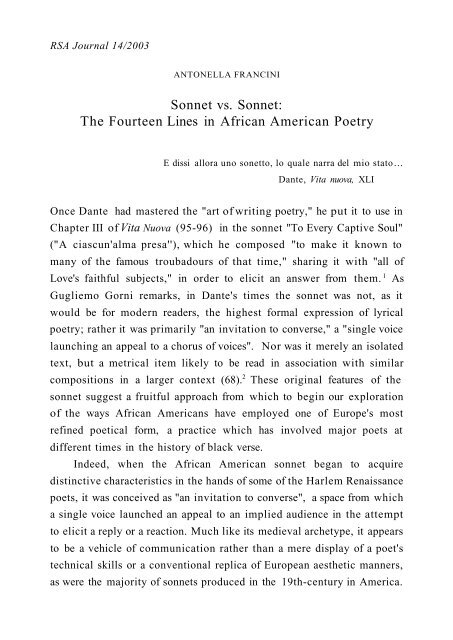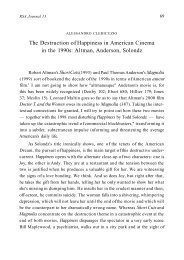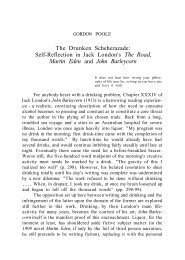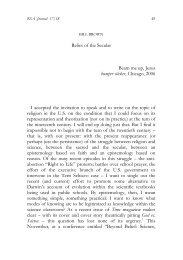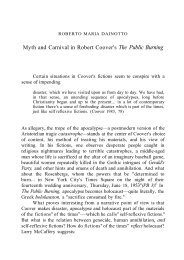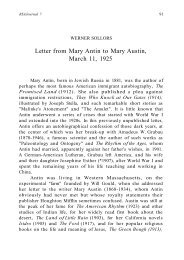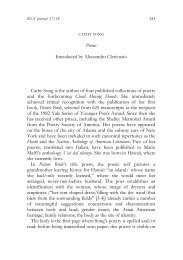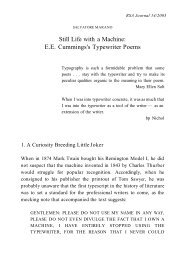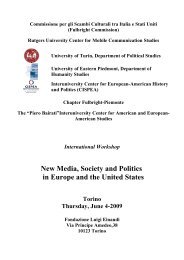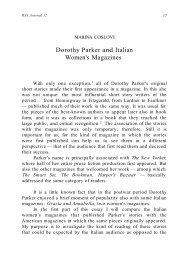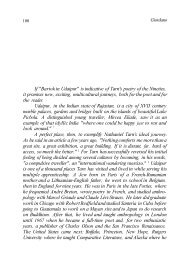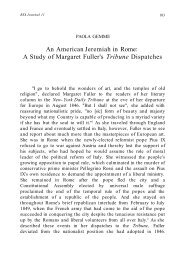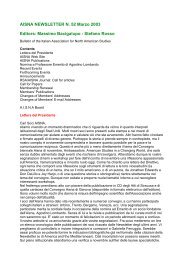Sonnet vs. Sonnet: The Fourteen Lines in African American Poetry
Sonnet vs. Sonnet: The Fourteen Lines in African American Poetry
Sonnet vs. Sonnet: The Fourteen Lines in African American Poetry
Create successful ePaper yourself
Turn your PDF publications into a flip-book with our unique Google optimized e-Paper software.
RSA Journal 14/2003<br />
ANTONELLA FRANCINI<br />
<strong>Sonnet</strong> <strong>vs</strong>. <strong>Sonnet</strong>:<br />
<strong>The</strong> <strong>Fourteen</strong> <strong>L<strong>in</strong>es</strong> <strong>in</strong> <strong>African</strong> <strong>American</strong> <strong>Poetry</strong><br />
E dissi allora uno sonetto, lo quale narra del mio stato...<br />
Dante, Vita nuova, XLI<br />
Once Dante had mastered the "art of writ<strong>in</strong>g poetry," he put it to use <strong>in</strong><br />
Chapter III of Vita Nuova (95-96) <strong>in</strong> the sonnet "To Every Captive Soul"<br />
("A ciascun'alma presa''), which he composed "to make it known to<br />
many of the famous troubadours of that time," shar<strong>in</strong>g it with "all of<br />
Love's faithful subjects," <strong>in</strong> order to elicit an answer from them. 1 As<br />
Gugliemo Gorni remarks, <strong>in</strong> Dante's times the sonnet was not, as it<br />
would be for modern readers, the highest formal expression of lyrical<br />
poetry; rather it was primarily "an <strong>in</strong>vitation to converse," a "s<strong>in</strong>gle voice<br />
launch<strong>in</strong>g an appeal to a chorus of voices". Nor was it merely an isolated<br />
text, but a metrical item likely to be read <strong>in</strong> association with similar<br />
compositions <strong>in</strong> a larger context (68). 2 <strong>The</strong>se orig<strong>in</strong>al features of the<br />
sonnet suggest a fruitful approach from which to beg<strong>in</strong> our exploration<br />
of the ways <strong>African</strong> <strong>American</strong>s have employed one of Europe's most<br />
ref<strong>in</strong>ed poetical form, a practice which has <strong>in</strong>volved major poets at<br />
different times <strong>in</strong> the history of black verse.<br />
Indeed, when the <strong>African</strong> <strong>American</strong> sonnet began to acquire<br />
dist<strong>in</strong>ctive characteristics <strong>in</strong> the hands of some of the Harlem Renaissance<br />
poets, it was conceived as "an <strong>in</strong>vitation to converse", a space from which<br />
a s<strong>in</strong>gle voice launched an appeal to an implied audience <strong>in</strong> the attempt<br />
to elicit a reply or a reaction. Much like its medieval archetype, it appears<br />
to be a vehicle of communication rather than a mere display of a poet's<br />
technical skills or a conventional replica of European aesthetic manners,<br />
as were the majority of sonnets produced <strong>in</strong> the 19th-century <strong>in</strong> America.
38 Antonella Franc<strong>in</strong>i<br />
In outl<strong>in</strong><strong>in</strong>g a history of the <strong>African</strong> <strong>American</strong> sonnet, then, one does well<br />
to beg<strong>in</strong> from this turn<strong>in</strong>g po<strong>in</strong>t <strong>in</strong> its evolution — the Harlem<br />
Renaissance period — when, once they had mastered "the art of writ<strong>in</strong>g<br />
poetry," certa<strong>in</strong> black poets moved away from the norm, and gave this<br />
metrical form new vitality. In mak<strong>in</strong>g it one of their chosen modes of<br />
expression, these poets succeeded <strong>in</strong> recover<strong>in</strong>g the sonnet's orig<strong>in</strong>al<br />
function centuries after its birth and with<strong>in</strong> a very different cultural<br />
sett<strong>in</strong>g. In their hands, the fourteen-l<strong>in</strong>e structure turns <strong>in</strong>to an ideal<br />
forum, a public space for dynamic argumentation of social and political<br />
themes directed to a specific category of readers.<br />
A case <strong>in</strong> po<strong>in</strong>t is the celebrated 1919 poem "If We Must Die," by<br />
Claude McKay, one of the lead<strong>in</strong>g figures of the Harlem Renaissance and<br />
the author of a significant number of sonnets built around the <strong>African</strong><br />
<strong>American</strong> experience:<br />
If we must die, let it not be like hogs<br />
Hunted and penned <strong>in</strong> an <strong>in</strong>glorious spot,<br />
While round us bark the mad and hungry dogs,<br />
Mak<strong>in</strong>g their mock at our accursèd lot.<br />
If we must die, O let us nobly die,<br />
So that our precious blood may not be shed<br />
In va<strong>in</strong>; then even the monsters we defy<br />
Shall be constra<strong>in</strong>ed to honor us though dead!<br />
o k<strong>in</strong>smen! we must meet the common foe!<br />
Though far outnumbered let us show us brave,<br />
And for their thousand blows deal one death- blow!<br />
What though before us lies the open grave?<br />
Like men we'll face the murderous, cowardly pack,<br />
Pressed to the wall, dy<strong>in</strong>g, but fight<strong>in</strong>g back. 3<br />
Divided <strong>in</strong>to three quatra<strong>in</strong>s and a clos<strong>in</strong>g rhym<strong>in</strong>g couplet, the poem is<br />
formally an English sonnet tightly constructed around an idea (if we
<strong>The</strong> <strong>Fourteen</strong> <strong>L<strong>in</strong>es</strong> <strong>in</strong> <strong>African</strong>-<strong>American</strong> <strong>Poetry</strong><br />
must die, let us die with honor), which the poet develops <strong>in</strong> the first two<br />
parts. <strong>The</strong> hypothetical premise repeated at the beg<strong>in</strong>n<strong>in</strong>g of l<strong>in</strong>es 1 and<br />
5 l<strong>in</strong>ks these two sections through a dexterous handl<strong>in</strong>g of grammar and<br />
diction. <strong>The</strong> shift from the negative subjunctive <strong>in</strong> the second hemistich<br />
of the first l<strong>in</strong>e ("let it not be like hogs") to the affirmative <strong>in</strong> l<strong>in</strong>e 5 ("O<br />
let us nobly die") <strong>in</strong>dicates a progression from fear to bravery, from<br />
passivity to action, from "an <strong>in</strong>glorious spot" to a noble position. <strong>The</strong><br />
imagery <strong>in</strong> these two quatra<strong>in</strong>s also marks a shift of focus: <strong>in</strong> the first two<br />
l<strong>in</strong>es of each one the speaker exhorts his companions to revolt, while <strong>in</strong><br />
the last two he calls attention to the oppressors. Plac<strong>in</strong>g the volta at l<strong>in</strong>e<br />
9, <strong>in</strong>stead of at l<strong>in</strong>e 13 as an English sonnet would do, is another sign of<br />
McKay's skilful handl<strong>in</strong>g of the sonnet form. <strong>The</strong> turn <strong>in</strong> fact signals the<br />
abandonment of the symmetrical structure and the hypothetical form,<br />
thus unbalanc<strong>in</strong>g the pace of the poem, as if he now <strong>in</strong>tended to mimic<br />
the turmoil of an actual fight. Moreover, the thought <strong>in</strong> the third<br />
quatra<strong>in</strong> is fractured by the strong caesura at the beg<strong>in</strong>n<strong>in</strong>g of l<strong>in</strong>e 9, by<br />
the irregular accents, and by l<strong>in</strong>e 12, which appears to be separated from<br />
the previous three l<strong>in</strong>es, be<strong>in</strong>g <strong>in</strong> fact a bridge to the clos<strong>in</strong>g couplet. <strong>The</strong><br />
structure of a Petrarchan sonnet looms beh<strong>in</strong>d the English one, with the<br />
sestet resolv<strong>in</strong>g what the octave has projected: the <strong>in</strong>evitable clash of the<br />
<strong>in</strong>human "cowardly pack" with the speaker's k<strong>in</strong>smen and their certa<strong>in</strong>,<br />
yet honorable, death. <strong>The</strong> alternate rhyme scheme further confirms the<br />
rhetorical framework of the sonnet: "hogs" connected with "dogs"<br />
underl<strong>in</strong>es the bestial nature of the persecutors, while "<strong>in</strong>glorious spot"<br />
rhym<strong>in</strong>g with "accursed lot" rem<strong>in</strong>ds the reader of the condition of the<br />
speaker's community; social resurrection through fight<strong>in</strong>g and death is<br />
stressed by the rhymes "die-defy", "shed-dead", "foe-deathblow", and<br />
"brave-grave"; and the contrast between humanity and brutality is f<strong>in</strong>ally<br />
restated <strong>in</strong> the couplet, where the "fight<strong>in</strong>g back" of the oppressed men<br />
is opposed to the "cowardly pack" of the oppressors.<br />
Thus, a tactful handl<strong>in</strong>g of both technique and ideology guarantees<br />
39
40 Antonella Franc<strong>in</strong>i<br />
the poem's effectiveness. <strong>The</strong> space of the sonnet is <strong>in</strong>habited by the<br />
dissent<strong>in</strong>g voice of the black poet, who challenges the tradition this form<br />
stands for, replac<strong>in</strong>g the love theme with an open attack on Western<br />
culture, its contradictions and hypocrisies. Moreover, it should be noted<br />
that, although written aga<strong>in</strong>st the backdrop of the black urban upris<strong>in</strong>g<br />
across the United States <strong>in</strong> summer 1919, 4 McKay's poem does not<br />
identify the fight<strong>in</strong>g groups, thus achiev<strong>in</strong>g a resonance that goes beyond<br />
the <strong>American</strong> context. In his hands, the tight cage of the sonnet<br />
ultimately turns <strong>in</strong>to a dynamic vehicle for freedom and social justice. 5<br />
As has been noticed, 6 the poem echoes the most famous speech <strong>in</strong><br />
Shakespeare's Henry V (Act IV, Scene III), <strong>in</strong> which, prior to the battle<br />
ofAg<strong>in</strong>court, the k<strong>in</strong>g exhorts his troops to fight bravely and with honor<br />
aga<strong>in</strong>st the overwhelm<strong>in</strong>g force of the French army. McKay exploits the<br />
episode, adapt<strong>in</strong>g its mode and diction to the racial violence <strong>in</strong> America,<br />
as evidenced by my italics <strong>in</strong> the follow<strong>in</strong>g l<strong>in</strong>es: "If we are marked to die,<br />
we are enow / To do our country loss; and if we live, / <strong>The</strong> fewer men, the<br />
greater share ofhonor ... For he to-day that sheds his blood with me / Shall<br />
be my brother ... And gentlemen <strong>in</strong> England now a-bed / Shall th<strong>in</strong>k<br />
themselves accurs'd they were not here..." 7 This <strong>in</strong>tertextual relation with<br />
Shakespeare's play not only conveys the speaker's trust <strong>in</strong> the victory of<br />
the oppressed over the oppressors (as Henry V's outnumbered army won<br />
over the French), but it also shows that the language of the European<br />
literary tradition can be appropriated by the black poet to construct new<br />
circuits ofmean<strong>in</strong>g. McKay's exploitation of this language performs what<br />
Ralph Ellison was to call "a technical assault aga<strong>in</strong>st the styles which<br />
have gone before" (183) as a form ofprotest <strong>in</strong> art that does not, however,<br />
necessarily espouse a specific political or social program.<br />
In another McKay sonnet, "Birds of Prey," the Petrarchan form is<br />
comb<strong>in</strong>ed with imagery that recalls the passages <strong>in</strong> Milton's Paradise Lost<br />
where Satan is likened to a predatory bird ready to destroy Adam and<br />
Eve's harmony <strong>in</strong> Eden:
<strong>The</strong> <strong>Fourteen</strong> <strong>L<strong>in</strong>es</strong> <strong>in</strong> <strong>African</strong>-<strong>American</strong> <strong>Poetry</strong><br />
<strong>The</strong>ir shadow dims the sunsh<strong>in</strong>e of our day,<br />
As they go lumber<strong>in</strong>g across the sky,<br />
Squawk<strong>in</strong>g <strong>in</strong> joy of feel<strong>in</strong>g safe on high,<br />
Beat<strong>in</strong>g their heavy w<strong>in</strong>gs of owlish gray.<br />
<strong>The</strong>y scare the s<strong>in</strong>g<strong>in</strong>g birds of the earth away<br />
As, greed-impelled, they circle threaten<strong>in</strong>gly,<br />
Watch<strong>in</strong>g the toilers with malignant eye,<br />
From their exclusive haven — birds of prey.<br />
<strong>The</strong>y swoop down for the spoil <strong>in</strong> certa<strong>in</strong> might,<br />
And fasten <strong>in</strong> our bleed<strong>in</strong>g flesh their claws.<br />
<strong>The</strong>y beat us to surrender weak with freight.<br />
And tugg<strong>in</strong>g and tear<strong>in</strong>g without let or pause,<br />
<strong>The</strong>y flap their hideous w<strong>in</strong>gs <strong>in</strong> grim delight,<br />
And stuff our gory hearts <strong>in</strong>to their maws. (174)<br />
Here is Book III, l<strong>in</strong>es 431-441, of Milton's poem, where Satan is<br />
bent like a vulture on his <strong>in</strong>nocent prey:<br />
As when a vulture, on Imaus bred,<br />
Whose snowy ridge of rov<strong>in</strong>g Tartar bounds,<br />
Dislodg<strong>in</strong>g from a region scarce of prey<br />
To gorge the flesh of lambs or yeanl<strong>in</strong>g kids<br />
On hills where flocks are fed, flies toward the spr<strong>in</strong>gs<br />
Of Ganges or H ydaspes, Indian streams,<br />
So, on this w<strong>in</strong>dy sea of land, the Fiend<br />
Walked up and down alone bent on his prey...<br />
<strong>The</strong> posture of Milton's hero is echoed <strong>in</strong> McKay's l<strong>in</strong>es; once aga<strong>in</strong><br />
he <strong>in</strong>troduces a political theme by borrow<strong>in</strong>g and manipulat<strong>in</strong>g material<br />
from the tradition of the dom<strong>in</strong>at<strong>in</strong>g culture. <strong>The</strong> contrast between evil<br />
forces, associated with dark tonalities, and their victims, associated with<br />
41
42 Antonella Franc<strong>in</strong>i<br />
the light ("sunsh<strong>in</strong>e" and "s<strong>in</strong>g<strong>in</strong>g birds"), established by McKay <strong>in</strong> the<br />
octave of his sonnet, f<strong>in</strong>ds its resolution at the end of l<strong>in</strong>e 8, when the<br />
om<strong>in</strong>ous shadows described above become "birds of prey," mark<strong>in</strong>g the<br />
volta of the poem. In the sestet the contrast between good and evil<br />
precipitates <strong>in</strong>to bloodshed, vividly outl<strong>in</strong>ed by the speaker, himself a<br />
victim <strong>in</strong> the bloody clash. In this case, too, McKay's usage of personal<br />
pronouns ("them" versus "us") makes the sonnet resound beyond the<br />
<strong>American</strong> historical context, creat<strong>in</strong>g a poetical space with<strong>in</strong> which<br />
power structures are challenged and the contradictions of modern<br />
democracies disclosed. <strong>The</strong> ma<strong>in</strong> trope the poet uses here — the w<strong>in</strong>gs of<br />
birds ofprey — also recalls the image of the eagle, the emblem of empires<br />
<strong>in</strong> Western culture, from classical Rome to the United States. 8<br />
Elsewhere Milton's hero serves McKay <strong>in</strong> his portrayal of the<br />
exclusion of blacks from their country's bounty and beauty and the<br />
consequent nourishment of hate and resentment that is their dest<strong>in</strong>y. See,<br />
for example, the sonnets "<strong>The</strong> White House," "<strong>The</strong> White City," and<br />
"America." "Outcast" is another sonnet where McKay portrays the black<br />
as "a ghost," "a th<strong>in</strong>g apart" and "out of time" because, we read, he is<br />
born "far from [his] native clime" and "[s]ometh<strong>in</strong>g <strong>in</strong> [him] is lost, for<br />
ever lost, / Some vital th<strong>in</strong>g has gone out of [his] heart." <strong>The</strong> turn<strong>in</strong>g<br />
po<strong>in</strong>t is <strong>in</strong> the second quatra<strong>in</strong>, where the black's hybrid cultural identity<br />
is acknowledged: "I would go back to darkness and to peace, / But the<br />
great western world holds me <strong>in</strong> fee, / And I may never hope for full<br />
release / While to its alien gods I bend my knee" (173). Among these<br />
"alien gods" there are the makers of the Western tradition and its forms,<br />
which are, as we have seen, <strong>in</strong>extricably woven <strong>in</strong>to the language of<br />
MacKay's sonnets, just as he is <strong>in</strong>extricably rooted <strong>in</strong> the Western culture<br />
that holds him "<strong>in</strong> fee."<br />
In other sonnets, McKay draws material from Christian imagery and<br />
diction <strong>in</strong> order to address directly the God that is the poet's silent<br />
<strong>in</strong>terlocutor, whom he questions about the reasons for human behavior
<strong>The</strong> <strong>Fourteen</strong> <strong>L<strong>in</strong>es</strong> <strong>in</strong> <strong>African</strong>-<strong>American</strong> <strong>Poetry</strong><br />
and whom he asks for sustenance. In the poem "Truth" he borrows<br />
Pilate's unanswered question to Jesus <strong>in</strong> the Gospel of St. John ("But<br />
what is Truth?") to weave a discourse on the elusiveness of the term:<br />
Oh, what is Truth? So Pilate asked <strong>The</strong>e, Lord,<br />
Two thousand years when Thou wert manifest,<br />
As the Eternal and Incarnate Word,<br />
Chosen of God and by Him s<strong>in</strong>gly blest:<br />
In this vast world of lies and hate and greed,<br />
Upon my knees, Oh Lord, for Truth I plead. (272)<br />
In such texts the Gospel tradition meets with the sonnet form, which<br />
appears a suitable narrative space for develop<strong>in</strong>g themes and images<br />
rem<strong>in</strong>iscent of <strong>African</strong> <strong>American</strong> folklore, the rhyme scheme and the<br />
implied musical accompaniment be<strong>in</strong>g another po<strong>in</strong>t of contact. In<br />
conclusion, the sonnet form is a mirror <strong>in</strong> which the <strong>African</strong> <strong>American</strong><br />
poet's self and heritage are reflected: the colonized subject, hav<strong>in</strong>g lost<br />
forever his or her orig<strong>in</strong>al identity, <strong>in</strong>terprets and reconstruct the colonizer's<br />
language and cultural patterns accord<strong>in</strong>g to his or her marg<strong>in</strong>alized<br />
perspective. That out of this a new eloquence is developed is not, <strong>in</strong><br />
Tzvetan Todorov's words apropos of historical <strong>in</strong>terpretations, "a<br />
superfluous ornament, but the mark of a greater 'truth-disclosure'" (140).<br />
<strong>The</strong> sonnets of Countee Cullen, the other well-known Harlem<br />
Renaissance sonneteer, are fashioned <strong>in</strong> a manner similar to McKay's. 9<br />
Whether they follow the English or the Italian model, or are a<br />
comb<strong>in</strong>ation of both, they also stand out as literary forums for the black<br />
poet to address a social <strong>in</strong>iquity, and <strong>in</strong>vite the reader to react. <strong>The</strong> fact<br />
that both the Jamaican-born McKay and Cullen were steeped <strong>in</strong> British<br />
poetry from early on expla<strong>in</strong>s only <strong>in</strong> part their adoption of traditional<br />
forms. <strong>The</strong>ir recovery of formal poetry just at the time when free verse<br />
was shap<strong>in</strong>g the new poetry of the 20th century, and theories about the<br />
43
44 Antonella Franc<strong>in</strong>i<br />
impersonality and the objectivity of art predom<strong>in</strong>ated, responds to an<br />
<strong>in</strong>tentional strategy and accounts, as Carol Miller suggested, for "an<br />
alternative modernist consciousness" (51). 10 Tradition is resumed,<br />
appropriated and subverted by a strong poetical subject who transforms the<br />
established lyrical canons <strong>in</strong>to what Adrienne Rich calls "a rebellious cry",<br />
"a poetics of resistance" (2).<br />
[A]lthough very conscious of the new criticism and trends <strong>in</strong> poetry, to which<br />
I am keenly responsive and receptive [McKay wrote <strong>in</strong> a prefatory note to his<br />
1922 collection Harlem Shadows], I have adhered to such of the older traditions<br />
as I f<strong>in</strong>d adequate for my most lawless and revolutionary passions and moods<br />
... I have not hesitated to use words which are old, and <strong>in</strong> some circles<br />
considered poetically overworked and dead, when I thought I could make them<br />
glow alive by new manipulation. (Harlem xx)<br />
Such 'manipulation' was not new <strong>in</strong> black verse. As far back as the<br />
18th century, Phyllis Wheatley <strong>in</strong>augurated this technique <strong>in</strong>sert<strong>in</strong>g<br />
racial motifs <strong>in</strong> the European-derived metrical constructions collected <strong>in</strong><br />
her only volume, Poems on Various Subjects Religious and Moral (1773).<br />
Texts such as "To the Right Honorable William, Earl of Dartmouth, His<br />
Majesty's Pr<strong>in</strong>cipal Secretary of State for North-America, &c" and "On<br />
Be<strong>in</strong>g Brought from Africa to America," firmly based on British models,<br />
show awareness of the condition of slavery. In stanza four of the former<br />
poem, she develops her political discourse about New England's freedom<br />
from Great Brita<strong>in</strong> draw<strong>in</strong>g on her personal experience: "Should you, my<br />
lord, while you peruse my song, / Wonder from whence my love of<br />
Freedom sprung, / ... I, young <strong>in</strong> life, by seem<strong>in</strong>g cruel fate / Was snatch'd<br />
from A/ric's fancy'd happy seat ..." (82). 11 And when the sonnet entered<br />
<strong>African</strong> <strong>American</strong> poetry <strong>in</strong> the n<strong>in</strong>eteenth century, 12 two major black<br />
sonneteers, Henrietta Cordelia Ray and Paul Laurence Dunbar, made a<br />
first attempt at graft<strong>in</strong>g racial themes onto the fourteen l<strong>in</strong>es. Here is the
<strong>The</strong> <strong>Fourteen</strong> <strong>L<strong>in</strong>es</strong> <strong>in</strong> <strong>African</strong>-<strong>American</strong> <strong>Poetry</strong><br />
open<strong>in</strong>g of Ray's tribute to "Robert G. Shaw," commander <strong>in</strong> chief of an<br />
<strong>African</strong> <strong>American</strong> regiment at the battle of Fort Wagner dur<strong>in</strong>g the Civil<br />
War, followed by the beg<strong>in</strong>n<strong>in</strong>g of Dunbar's eulogy of Frederick<br />
Douglass:<br />
When War's red banners trailed along the sky,<br />
And many a manly heart grew all aflame<br />
With patriotic love and purest aim,<br />
<strong>The</strong>re rose a noble soul who dared to die,<br />
If only Right could w<strong>in</strong>. He heard the cry<br />
Of struggl<strong>in</strong>g bondmen and he quickly came ... 13<br />
Ah, Douglass, we have fallen on evil days,<br />
Such days' as thou, not even thou didst know,<br />
When thee, the eyes of that harsh long ago<br />
Saw, salient, at the cross of devious ways,<br />
And all the country heard thee with amaze ... 14<br />
Like all of the numerous impeccable Italian sonnets <strong>in</strong> Ray's portrait<br />
gallery of public and private figures, this one too is narrated from the<br />
outside <strong>in</strong> a voice which sounds detached from her subject matter,<br />
controlled as it is by a sense of decorum and deep reverence for the<br />
adopted metrical form and poetic tradition. Dunbar's voice, <strong>in</strong>stead,<br />
immediately appears <strong>in</strong>volved <strong>in</strong> the issue of slavery, as the "we" <strong>in</strong> the<br />
first l<strong>in</strong>e <strong>in</strong>dicates. Yet, as Marcellus Blount argues, "even the most<br />
dar<strong>in</strong>g of [Ray's and Dunbar's] poems are cautious; the freedom they<br />
achieve somewhat constra<strong>in</strong>t" (232), s<strong>in</strong>ce the voice of each poet is<br />
covered by the literacy and gender conventions of the form itself and by<br />
the tradition <strong>in</strong>herited from <strong>African</strong> <strong>American</strong> political discourse. Still,<br />
these early examples allow us to observe a sort of pre-history of the black<br />
sonnet, a necessary apprenticeship provid<strong>in</strong>g the background for the<br />
45
46 Antonella Franc<strong>in</strong>i<br />
poets of the next generation who renewed the form. Moreover, these early<br />
poets' series of tributes to admired figures, <strong>in</strong>clud<strong>in</strong>g leaders of <strong>African</strong><br />
<strong>American</strong> history, provide an <strong>in</strong>terest<strong>in</strong>g prototype for the sonnet<br />
sequences and long poems made up of stanza-like sonnets which post<br />
modern and contemporary black poets have created <strong>in</strong> their attempt to<br />
develop a modern eloquence out of tradition, propose an alternative<br />
<strong>in</strong>terpretation of this tradition, and come to terms with its complex<br />
relationship with race.<br />
Gwendolyn Brooks employed the sonnet form <strong>in</strong> her early poetry,<br />
especially <strong>in</strong> her first collections, A Street <strong>in</strong> Bronzeville (1945) and Annie<br />
Allen (1949). <strong>The</strong> last section of the former is a cycle of twelve sonnets<br />
entitled "Gay Chaps At the Bar" — a "souvenir", as the dedication<br />
declares, for the author's brother, Staff Sergeant Raymond Brooks, active<br />
<strong>in</strong> World War II, and for every other soldier (Blacks 64). Here are Brooks's<br />
words on the poems' genesis:<br />
I first wrote the one sonnet, without th<strong>in</strong>k<strong>in</strong>g of extensions. I wrote it because<br />
of a letter I got from a soldier who <strong>in</strong>cluded that phrase (the title of the series<br />
of twelve sonnets and of the first sonnet) <strong>in</strong> what he was tell<strong>in</strong>g me; and then<br />
I said, there are other th<strong>in</strong>gs to say about what's go<strong>in</strong>g on at the front and all,<br />
and I'll write more poems, some of them based on the stuff of letters that I was<br />
gett<strong>in</strong>g from several soldiers, and I felt it would be good to have them all <strong>in</strong><br />
the same form, because it would serve my purpose throughout. (Report 158)<br />
Words from that first letter by Lieutenant William Couch stationed <strong>in</strong><br />
the South Pacific are quoted <strong>in</strong> the epigraph ("and guys I knew <strong>in</strong> the<br />
States, young officers, return from the front cry<strong>in</strong>g and trembl<strong>in</strong>g. Gay<br />
chaps at the bar <strong>in</strong> Los Angeles, Chicago, New York"), thus <strong>in</strong>troduc<strong>in</strong>g<br />
the theme of the sequence — a somber meditation on war by black (and<br />
white) soldiers whose experience <strong>in</strong> combat has turned their youthful<br />
cheerfulness <strong>in</strong>to fear, their hopes <strong>in</strong>to sorrow and doubt. Ghost-like, the
<strong>The</strong> <strong>Fourteen</strong> <strong>L<strong>in</strong>es</strong> <strong>in</strong> <strong>African</strong>-<strong>American</strong> <strong>Poetry</strong><br />
letter format stands beh<strong>in</strong>d these pieces, each one narrated by a different<br />
voice so that the entire cycle ultimately sounds polyphonic. <strong>The</strong> poet<br />
directs the soldiers' voices with mastery, channel<strong>in</strong>g them <strong>in</strong>to a unified<br />
work <strong>in</strong> which the chaps' words may cont<strong>in</strong>ue to bear witness, mov<strong>in</strong>g<br />
from the private sphere ofthe letter to the public forum ofpoetry. Indeed,<br />
Brooks's pseudo record of others' testimony is a very ref<strong>in</strong>ed literary<br />
operation, aim<strong>in</strong>g at wedd<strong>in</strong>g the <strong>in</strong>dividual history of her "corres<br />
pondents" with ma<strong>in</strong>stream Western culture. In her macro-text, the<br />
twelve sonnets take on the role of stanzas, yet each reta<strong>in</strong>s its <strong>in</strong>tegrity as<br />
an <strong>in</strong>dependent poem <strong>in</strong>habited by a dist<strong>in</strong>ctive voice.<br />
Like its medieval archetypes, Brooks's sequence achieves unity by<br />
address<strong>in</strong>g a s<strong>in</strong>gle theme, us<strong>in</strong>g specific metrical choices, and through<br />
repetitions of key words. <strong>The</strong> number twelve itself is rem<strong>in</strong>iscent of<br />
authoritative 13th- and 14th-century models of such cycles as Folgore da<br />
San Gimignano's sonnets on the months. "Gay Chaps" can <strong>in</strong> fact be read<br />
as a temporal sequence — a fictional year dur<strong>in</strong>g which the soldiers'<br />
<strong>in</strong>nocence surrenders to experience. In any case, Brooks also br<strong>in</strong>gs us to<br />
the heart of the European lyric tradition, mediated once aga<strong>in</strong> by the<br />
sonnet sequences of the English Renaissance, from Shakespeare's to John<br />
Donne's. 15 Yet her brief "canzoniere" is, <strong>in</strong> her own words, "a sonnet series<br />
<strong>in</strong> off-rhyme" for "an off-rhyme situation" (Report 158). It stems, one<br />
might say, from the poet's negotiation with tradition, history, and her<br />
own perspective as an <strong>African</strong> <strong>American</strong> poet who claims a historically<br />
active, if not political, role for poetry.<br />
<strong>The</strong> first sonnet <strong>in</strong> the cycle (Blacks 64-75) beautifully <strong>in</strong>troduces all<br />
these themes:<br />
We knew how to order. Just the dash<br />
Necessary. <strong>The</strong> length of gaiety <strong>in</strong> good taste.<br />
Whether the raillery should be slightly iced<br />
And given green, or served up hot and lush.<br />
47
48 Antonella Franc<strong>in</strong>i<br />
And we knew beautifully how to give to women<br />
<strong>The</strong> summer spread, the tropics, of our love.<br />
When to persist, or hold a hunger off.<br />
Knew white speech. How to make a look an omen.<br />
But noth<strong>in</strong>g ever taught us to be islands.<br />
And smart, athletic language for this hour<br />
Was not <strong>in</strong> the curriculum. No stout<br />
Lesson showed how to chat with death. We brought<br />
No brass fortissimo, among our talents,<br />
To holler down the lions <strong>in</strong> this air.<br />
Follow<strong>in</strong>g the model of the Petrarchan sonnet, this poem comes alive<br />
thanks to the license the poet takes. Abandon<strong>in</strong>g both a rigorous rhyme<br />
scheme and strict iambic pentameter metrics, Brooks calibrates<br />
assonances, alliterations, slant-rhymes, accents, enjambments and<br />
punctuation <strong>in</strong> order to create language <strong>in</strong> motion, language <strong>in</strong> the<br />
mak<strong>in</strong>g on the page, thereby mimick<strong>in</strong>g the thought process of the<br />
speaker. Speak<strong>in</strong>g through a collective "we," the soldier enumerates <strong>in</strong><br />
the octave a black man's resources vis-à-vis war and death, each<br />
emphasized by a careful distribution of accents which make the voice rise<br />
when knowledge is deployed. <strong>L<strong>in</strong>es</strong> 1 and 8 beg<strong>in</strong> appropriately with a<br />
spondaic rhythm. L<strong>in</strong>e 5 reiterates the accented verb "knew," which<br />
rhymes, as has been noticed, 16 with the first stressed syllable of<br />
"beautifully," thus reach<strong>in</strong>g a heightened effect by the position of these<br />
two words, placed as they are at the junction between anapest and dactyl.<br />
Such technique characterizes Brooks's prosody, as she plays with stressed<br />
and unstressed syllables also to control the length of the l<strong>in</strong>es,<br />
constructed to match the speaker's revelation of the blacks' strategies to<br />
control their social behavior <strong>in</strong> the dom<strong>in</strong>ant culture. <strong>The</strong> strong volta at<br />
9 ("But noth<strong>in</strong>g ever taught...") reverses what is stated <strong>in</strong> the octave and<br />
reveals the hollowness and falsity of the rhetorical <strong>in</strong>structions imparted
<strong>The</strong> <strong>Fourteen</strong> <strong>L<strong>in</strong>es</strong> <strong>in</strong> <strong>African</strong>-<strong>American</strong> <strong>Poetry</strong><br />
to soldiers, which offer "[n]o stout / lesson" on "how to chat with death."<br />
Spondaic feet prevail <strong>in</strong> the sestet, so that the speaker's voice sounds for<br />
the most part high-pitched, mimick<strong>in</strong>g, <strong>in</strong> this case, the fears of the<br />
soldiers at the front. It is here that, hav<strong>in</strong>g abandoned the social mask,<br />
blacks attempt salvation through their own culture. <strong>The</strong> terms "to<br />
holler" and "brass fortissimo" recall <strong>African</strong> <strong>American</strong> folklore and music.<br />
To be "at the bar" takes on, then, a multiple mean<strong>in</strong>g: it is not merely the<br />
bar of pleasant dr<strong>in</strong>ks, but also the color bar of segregation, the bar<br />
between life and death, and the bar that exposes a man to public<br />
judgment <strong>in</strong> combat or <strong>in</strong> court. And it is here, at the po<strong>in</strong>t where all<br />
cultural props break down, that the poet Brooks enters the poem,<br />
provid<strong>in</strong>g the soldiers, through her sonnet, with that "smart, athletic<br />
language" they lack to utter their newly learned war experience. Athletic<br />
<strong>in</strong>deed s<strong>in</strong>ce, as we have seen, poetic norms have been twisted and bent<br />
to give expression to the "off-rhyme" voices of the marg<strong>in</strong>alized subjects<br />
to whom Brooks's sonnet cycle pays the highest lyrical homage.<br />
<strong>The</strong> defeat of language, along with the poet's search for a vehicle of<br />
expression suitable to war poetry, functions as a strong <strong>in</strong>tertextual<br />
connection throughout the sequence. In sonnet 4, "look<strong>in</strong>g," the speak<strong>in</strong>g<br />
persona (the poet or a mother speak<strong>in</strong>g to and for all mothers of soldiers)<br />
decrees the <strong>in</strong>adequacy and impotence of her maternal l<strong>in</strong>guistic system<br />
at the moment of separation from her son:<br />
You have no word for soldiers to enjoy<br />
<strong>The</strong> feel of, as an apple, and to chew<br />
With mascul<strong>in</strong>e satisfaction. Not "good-by!"<br />
"Come back!" or "careful!" Look, and let him go.<br />
"Good-by!" is brutal, and "come back!" the raw<br />
Insistence of an idle desperation<br />
S<strong>in</strong>ce could he favor he would favor now.<br />
He will be "careful" if he has permission. (1-8)<br />
49
50 Antonella Franc<strong>in</strong>i<br />
In the sestet the speaker advises the mother to substitute speech<br />
with look<strong>in</strong>g ("Look<strong>in</strong>g is better. At the dissolution / Grab greatly with<br />
the eye...") although of "little avail" — an <strong>in</strong>vitation to dispense with<br />
rhetorical words and start over from the real data. <strong>The</strong> language fallacy<br />
also <strong>in</strong>volves the poet, who has no effective eloquence to offer a mother <strong>in</strong><br />
time of war. Her English sonnet can only register dissolution at more<br />
than one level.<br />
<strong>Sonnet</strong>s 10 and 11 explicitly mock the courtly love tradition<br />
embodied by the sonnet, whose stock imagery and l<strong>in</strong>guistic conventions<br />
are so totally at odds with war. <strong>The</strong> first, "love note I: surely," is a soldier's<br />
un-rhymed poem to his lover, who stands also for his country:<br />
Surely you stay my certa<strong>in</strong> own, you stay<br />
My you. All honest, lofty as a cloud.<br />
Surely I could come now and f<strong>in</strong>d you high,<br />
As m<strong>in</strong>e as you ever were; should not be awed ... (1-4)<br />
<strong>The</strong> adverb "surely" cont<strong>in</strong>ues to scan the progression of the poem <strong>in</strong> the<br />
follow<strong>in</strong>g l<strong>in</strong>es, placed <strong>in</strong> strategic positions to mark a predictable love<br />
story with a lofty lover — scornful and merciless as she must be. But past<br />
and gone are the times when love was an ennobl<strong>in</strong>g feel<strong>in</strong>g, as gone are<br />
the soldier's youthful <strong>in</strong>nocence and gaiety, his unconditioned faith <strong>in</strong> his<br />
country's democracy, and the poet's apprenticeship with tradition:<br />
Surely — But I am very off from that.<br />
From surely. From <strong>in</strong>deed. From the decent arrow<br />
That was my clean naiveté and my faith.<br />
This morn<strong>in</strong>g men deliver wounds and death.<br />
<strong>The</strong>y will deliver death and wounds tomorrow.<br />
And I doubt all. You. Or a violet. (9-14)
<strong>The</strong> <strong>Fourteen</strong> <strong>L<strong>in</strong>es</strong> <strong>in</strong> <strong>African</strong>-<strong>American</strong> <strong>Poetry</strong><br />
"love note II: flags" is a coda to the previous poem. Here the soldier<br />
attempts to recover the lover, now metamorphosed <strong>in</strong>to a flag flutter<strong>in</strong>g<br />
out "aga<strong>in</strong>st the pa<strong>in</strong>ed / volleys. Aga<strong>in</strong>st [his] power crumpled and wan"<br />
— a sarcastic allusion to the <strong>American</strong> flag, Old Glory:<br />
Still, it is dear defiance now to carry<br />
Fair flags of you above my <strong>in</strong>dignation,<br />
Top, with a pretty glory and a merry<br />
Softness, the scattered pound of my cold passion.<br />
I pull you down my foxhole. Do you m<strong>in</strong>d? (1-5)<br />
"Defiance" is a key word here: the soldier challenges war with memories<br />
of love as the poet challenges lyrical poetry by attack<strong>in</strong>g its conventions.<br />
Historically sterile, reduced to a "sweet mournfulness," as we read <strong>in</strong> the<br />
close, the sonnet form is however empowered anew by Brooks, who<br />
entrusts to its l<strong>in</strong>es a radical revision of its very tradition.<br />
<strong>The</strong> next poem, "the progress," ends the sequence on a somber note.<br />
<strong>The</strong> theme announced <strong>in</strong> the title is ironically deconstructed by the<br />
speaker who, resum<strong>in</strong>g the collective "we" of the first poem, looks<br />
om<strong>in</strong>ously at the recurr<strong>in</strong>g cycles of history, at troops who cont<strong>in</strong>ue to<br />
wear masks and play their part <strong>in</strong> a terrify<strong>in</strong>g war pantomime:<br />
And still we wear our uniforms, follow<br />
<strong>The</strong> cracked cry of the bugles, comb and brush<br />
Our pride and prejudice, doctor the sallow<br />
Initial ardor, wish to keep it fresh.<br />
Still we applaud the President's voice and face.<br />
Still we remark on patriotism, s<strong>in</strong>g,<br />
Salute the flag, thrill heavily, rejoice<br />
For death of men who too saluted, sang. (1-8)<br />
51
52 Antonella Franc<strong>in</strong>i<br />
<strong>The</strong> sestet discloses the truth of the matter as fear, "a deepen<strong>in</strong>g hollow<br />
through the cold," takes over. "Cold," a word appear<strong>in</strong>g <strong>in</strong> almost all<br />
the sonnets and thus function<strong>in</strong>g as a strong lexical l<strong>in</strong>k among them,<br />
is a synonym of death, contrast<strong>in</strong>g the tropical warmth of the black<br />
soldiers mentioned <strong>in</strong> the first poem, which is swept away by the force<br />
of war. <strong>The</strong> ephemeral music of love (another re-occurr<strong>in</strong>g image <strong>in</strong><br />
these texts) and its poetical counterpart <strong>in</strong> the end turn <strong>in</strong>to the<br />
frighten<strong>in</strong>g sound of march<strong>in</strong>g armies by means of a dexterous<br />
distribution of stresses: "Listen, listen. <strong>The</strong> step / Of iron feet aga<strong>in</strong>.<br />
And aga<strong>in</strong> wild."<br />
Read<strong>in</strong>g through the entire sequence, we are struck by Brooks's<br />
artistry <strong>in</strong> develop<strong>in</strong>g her narrative as she approaches her theme from<br />
multiple perspectives, each sonnet becom<strong>in</strong>g a plastic, flexible element<br />
conta<strong>in</strong><strong>in</strong>g the myriad of voices, tonal nuances, and semantic layers of her<br />
densely imag<strong>in</strong>ative language. Much like a musical motif played by a<br />
polyphonic orchestra, Brooks's well-tempered <strong>in</strong>struments render the<br />
sound of history, be it through black soldiers' meditations or through<br />
characters from the Chicago suburbs she was familiar with. It is <strong>in</strong><br />
creat<strong>in</strong>g such a choral effect that the sonnet form f<strong>in</strong>ds its raison-d'être <strong>in</strong><br />
her writ<strong>in</strong>g. Far from be<strong>in</strong>g restrict<strong>in</strong>g, it magnificently encompasses a<br />
broad gamut of social, political and human concerns. And as a cycle, it<br />
allows a constant shift of perspective from micro- to macro-text.<br />
In her Pulitzer prize book, Annie Allen, Brooks's sonnets also fit <strong>in</strong>to<br />
a larger context as stanzas or sections of a narrative. See, for example, the<br />
sequence "the children of the poor," five Petrarchan pieces at the open<strong>in</strong>g<br />
of the third section. Or "the sonnet-ballad," third poem <strong>in</strong> the appendix<br />
to the second section, "<strong>The</strong> Anniad," Brooks's most virtuoso exploit <strong>in</strong><br />
this volume with an impressive number of rhyme schemes. <strong>The</strong><br />
orig<strong>in</strong>ality of this poem's form is declared <strong>in</strong> the title: 17 a fusion of the<br />
highly traditional and the oral patterns of folk songs as a solo voice, a<br />
young woman's, chants her apprehension for her lover gone off to war:
<strong>The</strong> <strong>Fourteen</strong> <strong>L<strong>in</strong>es</strong> <strong>in</strong> <strong>African</strong>-<strong>American</strong> <strong>Poetry</strong><br />
Oh mother, mother, where is happ<strong>in</strong>ess?<br />
<strong>The</strong>y took my lover's tallness off to war.<br />
Left me lament<strong>in</strong>g. Now I cannot guess<br />
What I can use an empty-cup for .... (1-4)<br />
<strong>The</strong> spoken fabric of the language, after all, never strays too far from<br />
Brooks's l<strong>in</strong>es, and, at least <strong>in</strong> her poetry of the forties, the sonnet appears<br />
to be a po<strong>in</strong>t of <strong>in</strong>tersection between the blues and lyrical poetry. 18<br />
Robert Hayden, 19 a contemporary of Brooks, wrote sonnets which<br />
primarily attract attention for their content. Whether personal or<br />
historical, his diction resonates with the deeply experienced, observed,<br />
viewed; his characters replenish the poems, expand<strong>in</strong>g beyond the limits<br />
of language; and <strong>in</strong> the background are the metrical forms that support<br />
mean<strong>in</strong>g. <strong>The</strong> sonnet "Frederick Douglass" takes its force from the first<br />
long phrase of the poem, constructed around a correspondence between<br />
Douglass and freedom:<br />
When it is f<strong>in</strong>ally ours, this freedom, this liberty, this beautiful<br />
and terrible th<strong>in</strong>g, needful to man as air,<br />
usable as earth; when it belongs at last to all,<br />
when it is truly <strong>in</strong>st<strong>in</strong>ct, bra<strong>in</strong> matter, diastole, systole,<br />
reflex action; when it is f<strong>in</strong>ally won; when it is more<br />
than the gaudy mumbo jumbo of politicians:<br />
this man, this Douglass, this former slave, this Negro<br />
beaten to his knees, exiled, vision<strong>in</strong>g a world<br />
where none is lonely, none hunted, alien,<br />
this man, superb <strong>in</strong> love and logic, this man<br />
shall be remembered. Oh, not with statues' rhetoric,<br />
not with legends and poems and wreaths of bronze alone,<br />
but with the lives grown out of this life, the lives<br />
flesh<strong>in</strong>g his dream of the beautiful, needful th<strong>in</strong>g. (62)<br />
53
54 Antonella Franc<strong>in</strong>i<br />
<strong>The</strong> reiteration of the demonstrative "this" keeps the man and liberty<br />
tightly l<strong>in</strong>ked, while expand<strong>in</strong>g the stature of the <strong>African</strong> <strong>American</strong> leader.<br />
<strong>The</strong> conjunction "when," <strong>in</strong> build<strong>in</strong>g up a vision of the triumph of justice,<br />
has a similar function. Subvert<strong>in</strong>g the sonnet's canon, Hayden places his<br />
volta <strong>in</strong> the middle of l<strong>in</strong>e 10, at the beg<strong>in</strong>n<strong>in</strong>g of the second phrase, where<br />
the <strong>in</strong>tensity previously accumulated comes to an end to give way to a<br />
vision of human resurrection <strong>in</strong> the name of freedom. <strong>The</strong> term freedom,<br />
with its qualifications, frames the poet's thought, placed as it is at the<br />
beg<strong>in</strong>n<strong>in</strong>g and evoked at the end. Although Hayden disrupts the sonnet<br />
form, it rema<strong>in</strong>s the backbone around which his powerful theme is<br />
entw<strong>in</strong>ed. Much like the Harlem Renaissance sonneteers, he <strong>in</strong>habits<br />
tradition br<strong>in</strong>g<strong>in</strong>g <strong>in</strong>to it the protest<strong>in</strong>g voice — almost hieratic <strong>in</strong> this case<br />
— of black history. But his dream of freedom also effects the chosen form,<br />
re<strong>in</strong>terpret<strong>in</strong>g it freely as if to make it reflect the theme it conveys. This<br />
technical liberty is even more evident <strong>in</strong> poems such as "<strong>The</strong> Burly Fad<strong>in</strong>g<br />
One" and "Letter" where the graphic arrangement of the fourteen l<strong>in</strong>es —<br />
with spaces to mark the passage from stanza to stanza — makes them<br />
respectively an English and a Petrarchan sonnet.<br />
Such experimentation with the fourteen l<strong>in</strong>es is frequent <strong>in</strong> post<br />
modern and contemporary <strong>American</strong> poetry, both by black and white<br />
poets. It is therefore necessary to establish criteria for identify<strong>in</strong>g a sonnet<br />
when we meet compositions of sonnet length, because they are not always<br />
meant to be sonnets. 20 In order to be a sonnet a poem must reta<strong>in</strong> some<br />
relation to its archetypal model besides mere length, and it must present<br />
at least one of the sonnet's constitutive elements: a recognizable rhyme<br />
scheme or metrical norm, rhetorical devices keep<strong>in</strong>g the parts connected,<br />
a certa<strong>in</strong> typographical arrangement on the page, and a complete<br />
thematic development. <strong>The</strong> poet's <strong>in</strong>tention to write a sonnet, declared<br />
<strong>in</strong> the title, <strong>in</strong> the content or <strong>in</strong> extratextual material, is also a way of<br />
recogniz<strong>in</strong>g a sonnet even though its morphology has been radically<br />
altered. Among various re<strong>in</strong>terpretations s<strong>in</strong>ce Brooks's sequences, the
<strong>The</strong> <strong>Fourteen</strong> <strong>L<strong>in</strong>es</strong> <strong>in</strong> <strong>African</strong>-<strong>American</strong> <strong>Poetry</strong><br />
stanza-like sonnet <strong>in</strong> a long poem has cont<strong>in</strong>ued to stand out as a<br />
dist<strong>in</strong>ctive response of <strong>American</strong> poets to the potential of the form. In<br />
their hands it has turned <strong>in</strong>to a most pliable tool to construct narratives<br />
— or modern 'canzonieri' — an open space which can be expanded ad<br />
<strong>in</strong>f<strong>in</strong>itum, yet rema<strong>in</strong>s a discreet frame apt to control and order material<br />
and voices with<strong>in</strong> a measured discourse redolent of literary echoes and<br />
traditions. Although this practice certa<strong>in</strong>ly <strong>in</strong>volves both black and white<br />
poets, 21 contemporary <strong>African</strong> <strong>American</strong>s have made a special con<br />
tribution with texts <strong>in</strong> which, once aga<strong>in</strong>, the Western tradition meets<br />
their own historical and cultural heritage.<br />
In Rita Dove's Mother Love (1995), the sonnet is the primary element<br />
<strong>in</strong> the poet's comb<strong>in</strong>atorial technique. <strong>The</strong> work takes the form of a<br />
narrative collage on the mother-daughter relation, call<strong>in</strong>g upon the<br />
Greek myth of Demeter and Persephone. <strong>The</strong> number fourteen (its half<br />
and its double), rather than meter or rhyme scheme, is here the pr<strong>in</strong>ciple<br />
that structures the volume's thirty-five poems <strong>in</strong>to seven sections." All<br />
but five are sonnets, though irregular, or poems related to this form; three<br />
— "Persephone <strong>in</strong> Hell," "<strong>The</strong> Bistro Styx," and "Her Island" — are<br />
narratives with<strong>in</strong> the narrative, poetical cycles of which the last two are,<br />
respectively, a sequence and a crown of sonnets. <strong>The</strong> numbers 14, 7, and<br />
28 are therefore more than just figures: they play metaphorically with<br />
womanhood as a totality that is split <strong>in</strong>to two halves, daughter and<br />
mother, and then doubled <strong>in</strong>to two adults as the daughter breaks loose<br />
from the mother to live her own life. This is the very theme of the<br />
classical myth Dove chooses to revisit, recast <strong>in</strong>to a late twentieth-century<br />
drama of loss and regeneration.<br />
In the prefatory note to the volume, "An Intact World," Dove<br />
attributes to the sonnet form historical value as a talisman, if not a<br />
defense, aga<strong>in</strong>st dissolution and chaos:<br />
<strong>The</strong> sonnet is a heile Welt, an <strong>in</strong>tact world where everyth<strong>in</strong>g is <strong>in</strong> sync, from the<br />
55
56 Antonella Franc<strong>in</strong>i<br />
stars down to the t<strong>in</strong>iest mite on a blade of grass. And if the "true" sonnet<br />
reflects the music of the spheres, it then follows that any variation from the<br />
strictly Petrarchan or Shakespearean forms represents a world gone awry.<br />
Or does it? Can't form also be a talisman aga<strong>in</strong>st dis<strong>in</strong>tegration? <strong>The</strong> sonnet<br />
defends itself aga<strong>in</strong>st the vicissitudes of fortune by its charmed structure, its<br />
beautiful bubble. All the while, though, chaos is lurk<strong>in</strong>g outside the gate.<br />
<strong>The</strong> ancient story of Demeter and Persephone is just such a tale of a violated<br />
world.<br />
<strong>Sonnet</strong>s seemed the proper mode for most of this work ... Much has been said<br />
about the many ways to "violate" the sonnet <strong>in</strong> the service of <strong>American</strong> speech<br />
or modern love or whatever; I will simply say that I like how the sonnet<br />
comforts even while its prim borders (but what a pretty fence!) are stultify<strong>in</strong>g;<br />
one is constantly bump<strong>in</strong>g up aga<strong>in</strong>st Order. <strong>The</strong> Demeter/Persephone cycle of<br />
betrayal and regeneration is ideally suited for this form s<strong>in</strong>ce all three —<br />
mother-goddess, daughter-consort and poet — are struggl<strong>in</strong>g to s<strong>in</strong>g <strong>in</strong> their<br />
cha<strong>in</strong>s.<br />
If "cha<strong>in</strong>s" is to be understood as the biological cycle of life, the endless<br />
patterns of order-disorder <strong>in</strong> history, <strong>in</strong>nocence-knowledge, death<br />
rebirth, etc., then to write with<strong>in</strong> prescribed formal molds appears a<br />
necessary choice reflect<strong>in</strong>g the poet's <strong>in</strong>tent to adhere anthropologically<br />
to human nature. Dove's s<strong>in</strong>g<strong>in</strong>g "<strong>in</strong> cha<strong>in</strong>s" is therefore a protest en<br />
travesti aga<strong>in</strong>st the pseudo-democracy of free verse, while the unorthodox<br />
forms of her sonnets become the objective correlative of a world where<br />
chaos and dis<strong>in</strong>tegration are <strong>in</strong>escapable. Her operation is an anti<br />
mimetic response to such reality, a discipl<strong>in</strong>e that keeps her poetry at a<br />
distance from the magma where all is possible. And her "violated"<br />
sonnets, as talismans aga<strong>in</strong>st dis<strong>in</strong>tegration, suggest a way of organiz<strong>in</strong>g<br />
poetical material so as not to get lost <strong>in</strong> the chaos, the creation of a new<br />
order parallel to what happens <strong>in</strong> the natural world once Persephone is<br />
condemned to live <strong>in</strong> Hell for one-third of the year. Here is one of these
<strong>The</strong> <strong>Fourteen</strong> <strong>L<strong>in</strong>es</strong> <strong>in</strong> <strong>African</strong>-<strong>American</strong> <strong>Poetry</strong><br />
texts, Persephone, Fall<strong>in</strong>g, which jo<strong>in</strong>s poetical tradition, mythical plot and<br />
the poet's subjectivity as female, <strong>American</strong> and black:<br />
One narcissus among the ord<strong>in</strong>ary beautiful<br />
flowers, one unlike all the others! She pulled,<br />
stooped to pull harder—<br />
when, sprung out of the earth<br />
on his glitter<strong>in</strong>g terrible<br />
carriage he claimed his due.<br />
It is f<strong>in</strong>ished. No one heard her.<br />
No one! She had strayed from the herd.<br />
(Remember: go straight to school.<br />
This is important, stop fool<strong>in</strong>g around!<br />
Don't answer to strangers. Stick<br />
with your playmates. Keep your eyes down.)<br />
This is how easily the pit<br />
opens. This is how one foot s<strong>in</strong>ks <strong>in</strong>to the ground. (9)<br />
<strong>The</strong> break between octave and sestet and the strong volta at l<strong>in</strong>e 9 recall<br />
the Italian form, while the few end- and <strong>in</strong>ternal rhymes and the overall<br />
phonic texture create <strong>in</strong>ternal cohesion. <strong>The</strong> parenthetical block <strong>in</strong>serts<br />
what may be a personal memory of the poet, activated by the<br />
mythological story — a technique Dove uses <strong>in</strong> other poems to <strong>in</strong>clude<br />
comments and different perspectives with<strong>in</strong> the sonnet, or to add new<br />
<strong>in</strong>formation.<br />
Mother Love ends with a crown of sonnets based on Dove's visit to<br />
temples <strong>in</strong> Sicily, the land of Persephone. <strong>The</strong> very last restates the<br />
cyclical image she has used throughout to tell the endless story of<br />
mothers and daughters: "Only Earth — wild / mother we can never leave<br />
... knows / no story's ever f<strong>in</strong>ished; it just goes / on, unnoticed <strong>in</strong> the<br />
57
58 Anronella Franc<strong>in</strong>i<br />
dark that's all/around us: blazed stones, the ground closed" (77). <strong>The</strong><br />
sonnet proves <strong>in</strong>deed to be "the proper form" for this work.<br />
Borrow<strong>in</strong>g Andrea Zanzotto's well-known neologism hypersonnet, we<br />
can call "Testimony," a long poem occupy<strong>in</strong>g the sixth section of Yusef<br />
Komunyakaa's collection Thieves of Paradise (1998), a double hypersonnet.<br />
This "quasi libretto," 23 as the poet referred to it, <strong>in</strong> fourteen sections of<br />
two stanzas with fourteen l<strong>in</strong>es each, lyrically narrates the life and art of<br />
the jazz musician Charlie Parker, from when he left Kansas City to his<br />
death. Each pair of poems stands for a l<strong>in</strong>e <strong>in</strong> a seem<strong>in</strong>gly English sonnet.<br />
If we observe the narrative of the musician's life, we realize that<br />
biographical events are covered <strong>in</strong> the first twelve sections (with<br />
perceptible breaks before parts IV, VIII, and XII to underl<strong>in</strong>e the passage<br />
from quatra<strong>in</strong> to quatra<strong>in</strong>), while the last two, be<strong>in</strong>g post mortem, appear<br />
separate, <strong>in</strong> correspondence to the clos<strong>in</strong>g couplet of an English sonnet.<br />
In the last four poems, <strong>in</strong> fact, the focus shifts from Parker himself to the<br />
<strong>in</strong>difference of the media to the human predicament of this musician,<br />
broken at thirty-four by drugs and alcohol, and to the legends which soon<br />
began to circulate about him. But though the pattern that such a read<strong>in</strong>g<br />
suggests is rather appeal<strong>in</strong>g, "Testimony" actually breaks the rules of the<br />
sonnet, reshap<strong>in</strong>g it <strong>in</strong>to a new form, one that is suitable to the creation<br />
of a contrast between the straightforward biographical data and the<br />
lyrical and imag<strong>in</strong>ative impulse of Parker's music. Komunyakaa calls his<br />
form the "ghost sonnet," that is a shadowy metrical presence that keeps<br />
the fourteen l<strong>in</strong>es tight and yet is, at the same time, elusive because of its<br />
extreme flexibility and irregularities.<br />
Written as a radio libretto commissioned by the Australian Broad<br />
cast<strong>in</strong>g Corporation, and later performed by an orchestra of thirty-two<br />
musicians, eleven s<strong>in</strong>gers and one actor at the Sydney Opera House,<br />
Kornunyakaa's double hypersonnet develops a language which strives to<br />
br<strong>in</strong>g poetry closer to music, thus recover<strong>in</strong>g the etymological mean<strong>in</strong>g<br />
of the form — a "little song" for musicians. As <strong>in</strong> Brooks's war sequence,
<strong>The</strong> <strong>Fourteen</strong> <strong>L<strong>in</strong>es</strong> <strong>in</strong> <strong>African</strong>-<strong>American</strong> <strong>Poetry</strong><br />
here too the f<strong>in</strong>al effect is polyphonic, s<strong>in</strong>ce each pair of sonnets is<br />
narrated by a different voice and <strong>in</strong>habited by a cast of figures who not<br />
only evoke the bebop age with all its protagonists, but also contribute to<br />
render a choral effect. This effect is further strengthened by the l<strong>in</strong>guistic<br />
experimentation of Komunyakaa, who works on various registers to<br />
evoke the jazz idiom of the hipsters of the 1940s and 1950s, collat<strong>in</strong>g<br />
scraps of Bird's biography and artistic <strong>in</strong>novations with black music<br />
heritage to create a harmonious whole. Here is one of Kornunyakaa's<br />
"song lyrics" — the second poem of the third section, where the poet<br />
attempts to translate Bird's music <strong>in</strong>to images, imag<strong>in</strong>atively<br />
improvis<strong>in</strong>g on his sound track:<br />
Purple dress. Midnight-blue.<br />
Dime-store floral pr<strong>in</strong>t<br />
blouse draped over a Botticellian<br />
pose. Tanger<strong>in</strong>e. He could blow<br />
<strong>in</strong>s<strong>in</strong>uation. A tra<strong>in</strong> whistle<br />
<strong>in</strong> the distance, gun shot<br />
through the ceil<strong>in</strong>g, a wood warbler<br />
back <strong>in</strong> the Ozarks at Lake<br />
Taneycomo, he'd harmonize<br />
them all. Celt deal<strong>in</strong>g <strong>in</strong> coal<br />
on the edge of sw<strong>in</strong>g. Blue<br />
dress. Carm<strong>in</strong>e. Yellow sapsucker,<br />
bodacius "zoot suit with the reet<br />
pleats" & shim sham shimmy. (93)<br />
To conclude, retrac<strong>in</strong>g the presence of the sonnet <strong>in</strong> <strong>African</strong><br />
<strong>American</strong> poetry leads us to abandon the traditional association of formal<br />
poetry with conservatism. In the hands of black poets, the sonnet<br />
becomes the site of a ref<strong>in</strong>ed poetical syncretism between Western<br />
59
60 Antonella Franc<strong>in</strong>i<br />
tradition and ethnic heritage, a potentially revolutionary and highly<br />
<strong>in</strong>novative mechanism of resistance aga<strong>in</strong>st cultural hegemony. From the<br />
Harlem Renaissance protest sonnets, to Brooks's and Komunyakaa's<br />
polyphonies, to Hayden's thematic usage of the form and Dove's talismanic<br />
poems, the fourteen l<strong>in</strong>es <strong>in</strong> <strong>African</strong> <strong>American</strong> poetry have opened a space<br />
with<strong>in</strong> tradition where, at least aesthetically, a dialogue between races and<br />
cultures seems possible. From these l<strong>in</strong>es, as <strong>in</strong> their medieval prototypes,<br />
an <strong>in</strong>vitation to converse is launched, by means of the great variety of<br />
hybrid forms black poets have devised. Ultimately, the sonnets are a<br />
powerful synecdoche of the historical drama of slavery and freedom,<br />
reflect<strong>in</strong>g the poet's history <strong>in</strong> the tension between metrical norm and the<br />
subject's voice. That sem<strong>in</strong>al topos <strong>in</strong> black literature, freedom, is born here<br />
out of the formal cha<strong>in</strong>s of the sonnet, to which the poet entrusts the high<br />
ethical role of testimony. Long live the sonnet, then, bear<strong>in</strong>g as it does the<br />
seeds of a message that resonates well beyond literary cont<strong>in</strong>gency.<br />
NOTES<br />
1. Here is the well-known orig<strong>in</strong>al passage: "propuosi di farlo sentire a molti li quali<br />
erano famosi trovatori <strong>in</strong> quello tempo: e con ciò fosse cosa che io avesse già veduto per<br />
me medesimo l'arte del dire parole per rima, propuosi di fare un sonetto, ne lo quale<br />
io salutasse tutti li fedeli d'Amore e pregandoli che giudicassero la mia visione, scrissi<br />
a loro ciò che io avea nel mio sonno veduto." <strong>The</strong> English translation is m<strong>in</strong>e.<br />
2. Gorni writes: "Il sonetto presenta connorati sensibilmente diversi da quelli che il<br />
lettore e l' autore moderno (rna già anche la tradizione lirica che fa capo al Petrarca) son<br />
disposti a riconoscere come caratteristici di quel genere metrico; sonetto non già come<br />
espressione dell'assoluto poetico, forma isolata e <strong>in</strong> sé perfetta della liricità, bensì, <strong>in</strong><br />
prima istanza, come proposta colloquiale, voce s<strong>in</strong>gola che fa appello a un coro di voci,<br />
<strong>in</strong>dividuo metrico candidato all'aggregazione testuale con altri suoi simili."<br />
3. Complete Poems 177. This poem has often received critical attention. I have benefited<br />
from Smith, Blount, Keller, Miller, Rich, and James.
<strong>The</strong> <strong>Fourteen</strong> <strong>L<strong>in</strong>es</strong> <strong>in</strong> <strong>African</strong>-<strong>American</strong> <strong>Poetry</strong><br />
4. McKay relates its genesis <strong>in</strong> A Long Wayfrom Home 31-32, rpt. Complete Poems 332<br />
333.<br />
5. W<strong>in</strong>ston Churchill read this poem to British troops <strong>in</strong> Japan dur<strong>in</strong>g World War II.<br />
It was also found on the body of an <strong>African</strong> <strong>American</strong> soldier killed <strong>in</strong> combat and,<br />
copied by hand, <strong>in</strong> the Attica prison <strong>in</strong> 1971, <strong>in</strong> the aftermath of an <strong>in</strong>mate upris<strong>in</strong>g.<br />
<strong>The</strong>se last two facts are reported <strong>in</strong> Miller 52. Yusef Komunyakaa (Blue Notes 6) reports<br />
that "If We Must Die" was also read <strong>in</strong>to the Congressional Record by Senator Henry<br />
Cabot Lodge.<br />
6. Keller's essay discusses some of the sources McKay used <strong>in</strong> construct<strong>in</strong>g his sonnets,<br />
<strong>in</strong>clud<strong>in</strong>g Shakespeare.<br />
7. <strong>The</strong> open<strong>in</strong>g l<strong>in</strong>e of McKay's poem also echoes Shakespeare's Measure for Measure,<br />
111.1.93: "If I must die, / I will encounter darkness as a bride, / And hug it <strong>in</strong> my arms"<br />
(see "Notes to the Poems," Complete Poems 333).<br />
8. In the sonnet "Tiger," a fierce attack on the <strong>American</strong> rhetoric of freedom and<br />
democratic missions <strong>in</strong> the world that McKay develops by associat<strong>in</strong>g the stripes of<br />
the <strong>American</strong> flag with the stripes of the fel<strong>in</strong>e of the title, the eagle figures among<br />
other emblems of the United States: "Europe and Africa and Asia wait / <strong>The</strong> touted<br />
New Deal of the New World's hand! / New systems will be built on race and hate, /<br />
<strong>The</strong> Eagle and the Dollar will command." This poem was first collected under this<br />
title <strong>in</strong> Selected Poems 47. Its orig<strong>in</strong>al version as poem 36 <strong>in</strong> the series "Cycle Ms." is<br />
now <strong>in</strong>cluded <strong>in</strong> McKay, Complete Poems 359: "Europe and Asia, Africa wait / A new<br />
Fascism, the <strong>American</strong> brand, / And new worlds will be built upon race and hate / And<br />
the Eagle and the Dollar will command."<br />
9. See for <strong>in</strong>stance the frequently anthologized sonnets "Yet Do I Marvel," orig<strong>in</strong>ally<br />
published <strong>in</strong> Cullen's first collection of poems, Color (1925), and "From the Dark<br />
Tower," from his second volume, <strong>The</strong> Black Christ and Other Poems (1929).<br />
10. Besides McKay and Cullen, other black poets of the modernist age wrote sonnets.<br />
Among them were Langston Hughes, Sterl<strong>in</strong>g Brown, Gwendolyn B. Bennett, Alice<br />
Dunbar-Nelson, James Weldon Johnson, and Melv<strong>in</strong> Tolson.<br />
11. We can also observe a similar process <strong>in</strong> Anglo-<strong>American</strong> poets. I am th<strong>in</strong>k<strong>in</strong>g, for<br />
61
62 Antonella Franc<strong>in</strong>i<br />
example, of William Cullen Bryant's sonnet "To Cole, <strong>The</strong> Pa<strong>in</strong>ter, Depart<strong>in</strong>g for<br />
Europe", where the poet establishes the terms of a comparison between <strong>American</strong> and<br />
European landscapes <strong>in</strong> the attempt to develop a mythology of the <strong>American</strong><br />
wilderness to oppose to the myth of Europe. Such a declaration of cultural<br />
<strong>in</strong>dependence stands aga<strong>in</strong>st the backdrop of an English sonnet.<br />
12. <strong>The</strong> sonnet first appeared <strong>in</strong> <strong>American</strong> poetry between 1776 and 1779 when<br />
Colonel David Humphrey, a Yale University graduate, aide <strong>in</strong> camp of George<br />
Wash<strong>in</strong>gton and member of diplomatic missions <strong>in</strong> Europe <strong>in</strong> the early years of the<br />
Republic, composed twelve occasional poems <strong>in</strong> this form. S<strong>in</strong>ce then, the sonnet has<br />
cont<strong>in</strong>ued to enjoy great popularity among <strong>American</strong> poets, reach<strong>in</strong>g its first<br />
apotheosis <strong>in</strong> the 19th century <strong>in</strong> the hands of the most popular and celebrated authors<br />
of the Romantic age. Expert versifiers such as Longfellow and Bryant produced Italian<br />
and English sonnets which still stand out among their best works. Both professional<br />
and amateur <strong>American</strong> writers of verse must have regarded the fourteen-l<strong>in</strong>e<br />
composition as the ideal mold to conta<strong>in</strong> their emotions and moods, if it is true that<br />
over two hundred "poets" wrote sonnets between the time of the Revolution and the<br />
first three decades of the 20th century.<br />
This data comes from an old study on the subject by Lewis Sterner who, however, does<br />
not <strong>in</strong>clude <strong>in</strong> his impressive list <strong>African</strong> <strong>American</strong> sonneteers. Besides Ray and<br />
Dunbar, other early black authors of sonnets are Frances E.W Harper, Joseph Seaman<br />
Cotter, and Rosalie Jones. For an overview of the history of the sonnet form <strong>in</strong><br />
<strong>American</strong> poetry see Franc<strong>in</strong>i, "In forma di sonetto."<br />
13. Several of Ray's sonnets are homage poems to admired historical or artistic figures<br />
of the Western tradition, from the Venus of Milo to Beethoven, Shakespeare, Milton,<br />
to Petrarch's Laura. One, "Toussa<strong>in</strong>t L'Ouverture," is dedicated to a black historical<br />
figure. Another one, addressed to her father, who was actively <strong>in</strong>volved <strong>in</strong> the abolition<br />
cause, touches the race issue.<br />
14. In like manner, Dunbar wrote his own tribute to Colonel Robert Gould Shaw.<br />
Here is the first quatra<strong>in</strong> of this Petrarchan sonnet: "Why was it that the thunder voice<br />
of Fate / Should call thee, studious, from the classic groves, / Where calm-eyed Pallas<br />
with still footstep roves, / And charge thee seek the turmoil of the state?" (Hayden,<br />
Kaleidoscope 25).
<strong>The</strong> <strong>Fourteen</strong> <strong>L<strong>in</strong>es</strong> <strong>in</strong> <strong>African</strong>-<strong>American</strong> <strong>Poetry</strong><br />
15. By elaborat<strong>in</strong>g on the British sonnet tradition, <strong>African</strong> <strong>American</strong> poets managed<br />
to recover the form's orig<strong>in</strong>al features. As is well known, the Petrarchan archetype was<br />
brought from Italy to England <strong>in</strong> the Renaissance by Wyatt and Surrey, who established<br />
the less rigid abab cdcd efef gg pattern, more suitable to English, a language less rich <strong>in</strong><br />
rhyme than Italian. Shakespeare, Spencer, Sidney, Donne and Milton heightened the<br />
sonnet form, and <strong>in</strong>troduced a wide variety of rhyme schemes, l<strong>in</strong>e length, and themes.<br />
By the time Wordsworth and Keats, the Rossettis, Elizabeth Barrett Brown<strong>in</strong>g,<br />
Hopk<strong>in</strong>s and Sw<strong>in</strong>burne revived it <strong>in</strong> the 19th century, the English sonnet had a claim<br />
to its own autonomous tradition, much broader <strong>in</strong> themes and metrical variations than<br />
the still relatively rigid Italian sonnet. <strong>The</strong>se British sonnet canons were immediately<br />
available to <strong>American</strong> poets for their formal tra<strong>in</strong><strong>in</strong>g. Brooks, however, relates that the<br />
first book of poetry she became familiar with was <strong>The</strong> Complete Paul Laurence Dunbar.She<br />
was then about 11 and already wrote poems; shortly after, she <strong>in</strong>troduced herself to the<br />
work of Langston Hughes and Countee Cullen (Report 56 and 170-73).<br />
16. Williams 218. Discussions of Brooks' sequence are also <strong>in</strong>cluded <strong>in</strong> Blount;<br />
Melhem, Schweik, Folwell, and Smethurst.<br />
17. On her "sonnet-ballad" Brooks wrote: "Its one claim to fame is that I <strong>in</strong>vented it"<br />
(Report 186).<br />
18. Brooks declared: "<strong>The</strong>re are th<strong>in</strong>gs colloquial and contemporary that can be done<br />
with the sonnet form" (Report 157).<br />
19. A third sonneteer of this generation is Margaret Walker. Six sonnets close her first<br />
book of poetry, ForMy People (1942).<br />
20. For <strong>in</strong>stance, of the seven fourteen-l<strong>in</strong>e poems <strong>in</strong>cluded <strong>in</strong> Hayden's Collected Poems,<br />
two ("Those W<strong>in</strong>ter Sundays" and "Monet's 'Waterlilies''') do not appear to be sonnets,<br />
not hav<strong>in</strong>g elements that would clearly identify them as such.<br />
21. Especially with the emergence of the New Formalist movement <strong>in</strong> the 1980s. On<br />
this subject see F<strong>in</strong>ch.<br />
22. On Dove's numerology <strong>in</strong> this collection see Cushman.<br />
23. Unpublished <strong>in</strong>terview. <strong>The</strong> follow<strong>in</strong>g comments on this text are from personal<br />
conversations with the poet.<br />
63
64 Antonella Franc<strong>in</strong>i<br />
WORKS CITED<br />
Alighieri, Dante. Vita Nuova. Milano: Rizzoli, 1984.<br />
Blount, Marcellus. "Caged Birds: Race and Gender <strong>in</strong> the <strong>Sonnet</strong>." Engender<strong>in</strong>g Men:<br />
<strong>The</strong> Question of Male Fem<strong>in</strong>ist Criticism. Ed. Joseph Boone and Michael Cadden. New<br />
York: Routledge, 1990. 225-238.<br />
Brooks, Gwendolyn. Blacks. Chicago: Third World Press, 1987.<br />
-. Report From Part One. Detroit: Broadside Press, 1972.<br />
Cushman, Stephen. "And the Dove Returned." Callaloo 19.1 (1996): 131-133.<br />
Dove, Rita. Mother Love. New York: WW. Norton & Company, 1995.<br />
Dunbar, Paul Laurence. Collected <strong>Poetry</strong> of Paul Laurence Dunbar. Ed. Joanna M. Braxton.<br />
Charlottesville: University Press of Virg<strong>in</strong>ia, 1993.<br />
Ellison, Ralph. "<strong>The</strong> World and the Jug." <strong>The</strong> Collected Essays. Ed. John F. Callahan.<br />
New York: <strong>The</strong> Modern Library 2003. 155-188.<br />
Folwell, Ann. "Dialectics of Desire: War and the Resistive Voice <strong>in</strong> Gwendolyn<br />
Brooks' 'Negro Hero' and 'Gay Chaps at the Bar'." <strong>African</strong> <strong>American</strong> Review 26 (1992):<br />
197-211.<br />
Franc<strong>in</strong>i, Antonella. "In forma di sonetto, ovvero i 14 versi nella poesia statunitense."<br />
Semicerchio. Rivista di poesia comparata 23 (2000): 24-28.<br />
Gorni, Gugliemo. Metrica eanalisi letteraria. Bologna: Il Mul<strong>in</strong>o, 1993.<br />
Hayden, Robert. Collected Poems. Ed. Frederick Glaysher. New York: Norton, 1985.<br />
-. Ed. Kaleidoscope: Poems by <strong>American</strong> Negro Poets. New York: Harcourt, Brace, 1967.<br />
James, W<strong>in</strong>ston. A Fierce Hatred of Injustice: Claude McKay's Jamaica and His <strong>Poetry</strong> of<br />
Rebellion. New York: Verso, 2000.<br />
Keller, James R. "'A Chaf<strong>in</strong>g Savage, Down the Decent Street': the Politic Compromise<br />
<strong>in</strong> Claude McKay's Protest <strong>Sonnet</strong>s." <strong>African</strong><strong>American</strong> Review 28.3 (Fall 1994): 447-456.
<strong>The</strong> <strong>Fourteen</strong> <strong>L<strong>in</strong>es</strong> <strong>in</strong> <strong>African</strong>-<strong>American</strong> <strong>Poetry</strong><br />
Komunyakaa, Yusef. Blue Notes: Essays, Interviews, and Commentaries. Ann Arbor:<br />
University of Michigan Press, 2000.<br />
-. II ritmodelle emozioni. Ed. Antonella Franc<strong>in</strong>i. Genova: Liberodiscrivere, 2004.<br />
-. Thieves of Paradise. New York: Wesleyan University Press, 1998<br />
McKay, Claude. Complete Poems. Ed. William J. Maxwell. Chicago: University of<br />
Ill<strong>in</strong>ois Press, 2004.<br />
-. Harlem Shadows: <strong>The</strong> Poems of Claude McKay. Introduction by Max Eastman. New<br />
York: Harcourt, Brace, 1922.<br />
-. A Long Way from Home. New York: Harcourt, Brace, 1970.<br />
-. Selected Poems of Claude McKay. New York: Bookman Associates, 1953.<br />
Melhem, D.H. Gwendolyn Brooks: <strong>Poetry</strong> and the Heroic Voice. Lex<strong>in</strong>gton: University<br />
Press of Kentucky, 1987.<br />
Miller, Carol E. "Toward an Alternative Formalist Tradition: <strong>The</strong> Other Harlem<br />
Renaissance." After New Formalism: Poets onForm, Narrative. Ed. Annie F<strong>in</strong>ch. Ashland,<br />
OR: Story L<strong>in</strong>e Press, 1999.48-59.<br />
Milton, John. Poetical Works. Ed. Douglas Bush. London: Oxford University Press,<br />
1966.<br />
Ray, Henrietta Cordelia. Poems. New York: Grafton Press, 1910.<br />
Rich, Adrienne. "Format and Form." After New Formalism: Poets onForm, Narrative. Ed.<br />
Annie F<strong>in</strong>ch. Ashland, OR: Story L<strong>in</strong>e Press, 1999. 1-7.<br />
Schweik, Susan. A Gulf So Deeply Cut: <strong>American</strong> Women Poets and the Second World War.<br />
Madison: University of Wiscons<strong>in</strong> Press, 1991<br />
Smethurst, James. <strong>The</strong> New Red Negro: <strong>The</strong> Literary Left and <strong>African</strong> <strong>American</strong> <strong>Poetry</strong>,<br />
1930-1946. New York: Oxford University Press, 1999.<br />
Smith, Gary. "<strong>The</strong> Black Protest <strong>Sonnet</strong>." <strong>American</strong> <strong>Poetry</strong> 2.1 (Fall 1984): 2-12.<br />
65
66 Antonella Franc<strong>in</strong>i<br />
Sterner, Lewis. <strong>The</strong> <strong>Sonnet</strong> <strong>in</strong> <strong>American</strong> Literature. Philadephia: Dissertation, 1930<br />
Shakespeare, William. <strong>The</strong> Riverside Shakespeare. Boston: Houghton Miffl<strong>in</strong> Company,<br />
1997.<br />
Todorov, Tzvetan. "Manipulation and Eloquence." <strong>The</strong> Morals of History. M<strong>in</strong>neapolis:<br />
University of M<strong>in</strong>nesota Press, 1995.126-140.<br />
Wheatley, Phyllis. <strong>The</strong> Poems of Phyllis Wheatley. Ed. Julian D. Mason Jr. Chapel Hill:<br />
University of North Carol<strong>in</strong>a Press, 1989.<br />
Williams, Gladys Margaret. "Gwendolyn Brooks's Way With the <strong>Sonnet</strong>." CLA<br />
Journal 26 (1982): 215-240.


